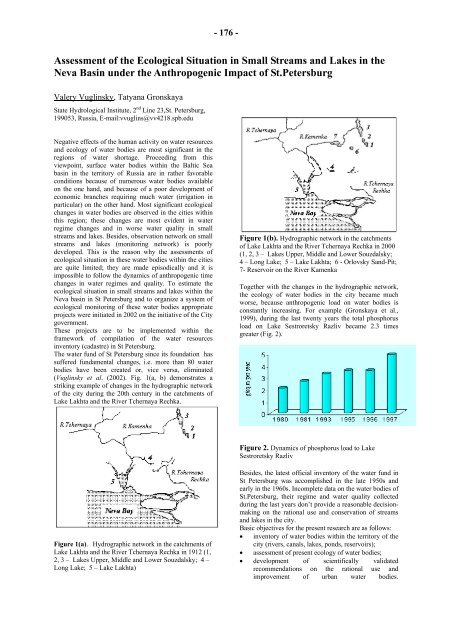Fourth Study Conference on BALTEX Scala Cinema Gudhjem
Fourth Study Conference on BALTEX Scala Cinema Gudhjem
Fourth Study Conference on BALTEX Scala Cinema Gudhjem
Create successful ePaper yourself
Turn your PDF publications into a flip-book with our unique Google optimized e-Paper software.
- 176 -<br />
Assessment of the Ecological Situati<strong>on</strong> in Small Streams and Lakes in the<br />
Neva Basin under the Anthropogenic Impact of St.Petersburg<br />
Valery Vuglinsky, Tatyana Gr<strong>on</strong>skaya<br />
State Hydrological Institute, 2 nd Line 23,St. Petersburg,<br />
199053, Russia, E-mail:vvuglins@vv4218.spb.edu<br />
Negative effects of the human activity <strong>on</strong> water resources<br />
and ecology of water bodies are most significant in the<br />
regi<strong>on</strong>s of water shortage. Proceeding from this<br />
viewpoint, surface water bodies within the Baltic Sea<br />
basin in the territory of Russia are in rather favorable<br />
c<strong>on</strong>diti<strong>on</strong>s because of numerous water bodies available<br />
<strong>on</strong> the <strong>on</strong>e hand, and because of a poor development of<br />
ec<strong>on</strong>omic branches requiring much water (irrigati<strong>on</strong> in<br />
particular) <strong>on</strong> the other hand. Most significant ecological<br />
changes in water bodies are observed in the cities within<br />
this regi<strong>on</strong>; these changes are most evident in water<br />
regime changes and in worse water quality in small<br />
streams and lakes. Besides, observati<strong>on</strong> network <strong>on</strong> small<br />
streams and lakes (m<strong>on</strong>itoring network) is poorly<br />
developed. This is the reas<strong>on</strong> why the assessments of<br />
ecological situati<strong>on</strong> in these water bodies within the cities<br />
are quite limited; they are made episodically and it is<br />
impossible to follow the dynamics of anthropogenic time<br />
changes in water regimes and quality. To estimate the<br />
ecological situati<strong>on</strong> in small streams and lakes within the<br />
Neva basin in St Petersburg and to organize a system of<br />
ecological m<strong>on</strong>itoring of these water bodies appropriate<br />
projects were initiated in 2002 <strong>on</strong> the initiative of the City<br />
government.<br />
These projects are to be implemented within the<br />
framework of compilati<strong>on</strong> of the water resources<br />
inventory (cadastre) in St Petersburg.<br />
The water fund of St Petersburg since its foundati<strong>on</strong> has<br />
suffered fundamental changes, i.e. more than 80 water<br />
bodies have been created or, vice versa, eliminated<br />
(Vuglinsky et al. (2002). Fig. 1(a, b) dem<strong>on</strong>strates a<br />
striking example of changes in the hydrographic network<br />
of the city during the 20th century in the catchments of<br />
Lake Lakhta and the River Tchernaya Rechka.<br />
Figure 1(a). Hydrographic network in the catchments of<br />
Lake Lakhta and the River Tchernaya Rechka in 1912 (1,<br />
2, 3 – Lakes Upper, Middle and Lower Souzdalsky; 4 –<br />
L<strong>on</strong>g Lake; 5 – Lake Lakhta)<br />
Figure 1(b). Hydrographic network in the catchments<br />
of Lake Lakhta and the River Tchernaya Rechka in 2000<br />
(1, 2, 3 – Lakes Upper, Middle and Lower Souzdalsky;<br />
4 – L<strong>on</strong>g Lake; 5 – Lake Lakhta; 6 - Orlovsky Sand-Pit;<br />
7- Reservoir <strong>on</strong> the River Kamenka<br />
Together with the changes in the hydrographic network,<br />
the ecology of water bodies in the city became much<br />
worse, because anthropogenic load <strong>on</strong> water bodies is<br />
c<strong>on</strong>stantly increasing. For example (Gr<strong>on</strong>skaya et al.,<br />
1999), during the last twenty years the total phosphorus<br />
load <strong>on</strong> Lake Sestroretsky Razliv became 2.3 times<br />
greater (Fig. 2).<br />
Figure 2. Dynamics of phosphorus load to Lake<br />
Sestroretsky Razliv<br />
Besides, the latest official inventory of the water fund in<br />
St Petersburg was accomplished in the late 1950s and<br />
early in the 1960s. Incomplete data <strong>on</strong> the water bodies of<br />
St.Petersburg, their regime and water quality collected<br />
during the last years d<strong>on</strong>’t provide a reas<strong>on</strong>able decisi<strong>on</strong>making<br />
<strong>on</strong> the rati<strong>on</strong>al use and c<strong>on</strong>servati<strong>on</strong> of streams<br />
and lakes in the city.<br />
Basic objectives for the present research are as follows:<br />
• inventory of water bodies within the territory of the<br />
city (rivers, canals, lakes, p<strong>on</strong>ds, reservoirs);<br />
• assessment of present ecology of water bodies;<br />
• development of scientifically validated<br />
recommendati<strong>on</strong>s <strong>on</strong> the rati<strong>on</strong>al use and<br />
improvement of urban water bodies.













